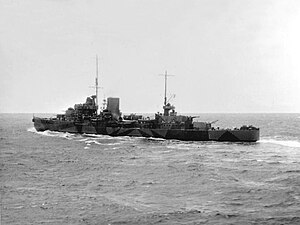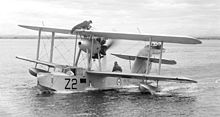
HMNZS Achilles was a Leander-class light cruiser, the second of five in the class. She served in the Royal New Zealand Navy in the Second World War. She was launched in 1931 for the Royal Navy, loaned to New Zealand in 1936 and transferred to the new Royal New Zealand Navy in 1941. She became famous for her part in the Battle of the River Plate, alongside HMS Ajax and HMS Exeter and notable for being the first Royal Navy cruiser to have fire control radar, with the installation of the New Zealand-made SS1 fire-control radar in June 1940.

The Royal New Zealand Navy is the maritime arm of the New Zealand Defence Force. The fleet currently consists of nine ships. The Navy had its origins in the Naval Defence Act 1913, and the subsequent purchase of the cruiser HMS Philomel, which by 1921 had been moored in Auckland as a training ship. A slow buildup occurred during the Interwar period, and then perhaps the infant Navy's finest hour occurred soon after the beginning of World War II when HMS Achilles fought alongside two other Royal Navy cruisers at the Battle of the River Plate in December 1939.

The Fiji-class cruisers were a class of eleven light cruisers of the Royal Navy that saw extensive service throughout the Second World War. Each ship of the class was named after a Crown colony or other constituent territory of the British Commonwealth and Empire. The class was also known as the Colony class, or Crown Colony class. Developed as more compact versions of the preceding Town-class cruisers, the last three were built to a slightly modified design and were sometimes also called the Ceylon class.

The Battle of Kolombangara was a naval battle of the Pacific campaign of World War II, fought on the night of 12/13 July 1943, off the northeastern coast of Kolombangara in the Solomon Islands. The battle took place during the early stages of the New Georgia campaign when an Imperial Japanese Navy force, carrying reinforcements south to Vila, Solomon Islands, was intercepted by a task force of U.S. and New Zealand light cruisers and destroyers. In the ensuing action, the Japanese sank one Allied destroyer and damaged three cruisers. They were also able to successfully land 1,200 ground troops on the western coast of Kolombangara but lost one light cruiser sunk in the process.

The Leander class was a class of eight light cruisers built for the Royal Navy in the early 1930s that saw service in World War II. They were named after mythological figures, and all ships were commissioned between 1933 and 1936. The three ships of the second group were sold to the Royal Australian Navy (RAN) before World War II and renamed after Australian cities.
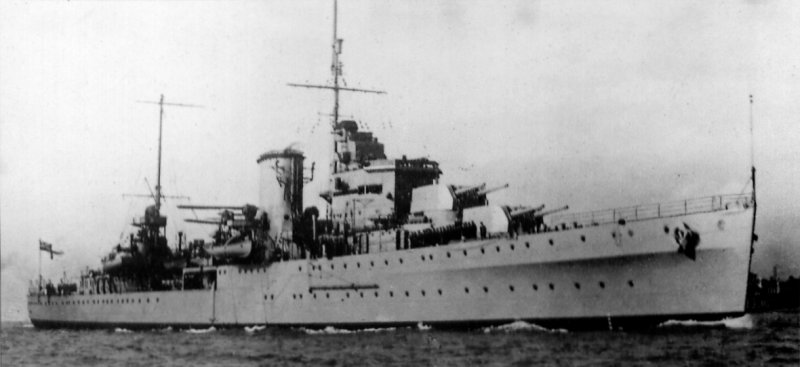
HMS Ajax was a Leander-class light cruiser which served with the Royal Navy during World War II. She became famous for her part in the Battle of the River Plate, the Battle of Crete, the Battle of Malta and as a supply escort in the siege of Tobruk. This ship was the eighth in the Royal Navy to bear the name. In February 1942, she was adopted by the civil community of Halifax.

HMS Neptune was a Leander-class light cruiser which served with the Royal Navy during World War II.

HMAS Hobart was a modified Leander-class light cruiser which served in the Royal Australian Navy (RAN) during World War II. Originally constructed for the Royal Navy as HMS Apollo, the ship entered service in 1936, and was sold to Australia two years later. During the war, Hobart was involved in the evacuation of British Somaliland in 1940, fought at the Battle of the Coral Sea and supported the amphibious landings at Guadalcanal and Tulagi in 1942. She was torpedoed by a Japanese submarine in 1943, then returned to service in 1945 and supported the landings at Tarakan, Wewak, Brunei, and Balikpapan. Hobart was placed in reserve in 1947, but plans to modernise her and return her to service as an aircraft carrier escort, training ship, or guided missile ship were not followed through. The cruiser was sold for scrapping in 1962.
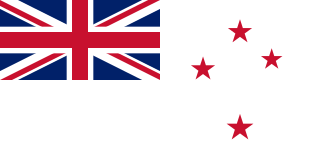
The history of the Royal New Zealand Navy leads back to early New Zealand-based gunboats used in controlling the British interests in the new colony, as well as to the strong linkages to the British Navy itself.

HMS Gambia was a Fiji-class light cruiser of the Royal Navy. She was in the service of the Royal New Zealand Navy (RNZN) as HMNZS Gambia from 1943 to 1946. She was named after the then Crown colony of the Gambia, and has been the only ship of the Royal Navy to bear the name.

Jintsū (神通) was the second vessel completed in the three-ship Sendai-class light cruiser in the Imperial Japanese Navy (IJN), named after the Jinzū River in the Gifu and Toyama prefectures of central Japan. She was active in World War II in various campaigns including the Japanese invasion of the Philippines, the Battle of the Java Sea, and Battle of Midway. On 13 July 1943 in the Battle of Kolombangara, she was discovered during a night attack by American ships and sunk in combat.
Captain Stephen Wentworth Roskill, was a senior career officer of the Royal Navy, serving during the Second World War and, after his enforced medical retirement, served as the official historian of the Royal Navy from 1949 to 1960. He is now chiefly remembered as a prodigious author of books on British maritime history.
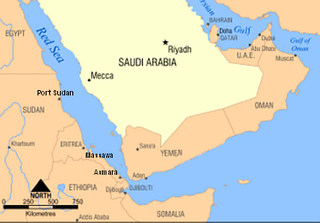
The Red Sea Flotilla was part of the Regia Marina Italia based at Massawa in the colony of Italian Eritrea, part of Italian East Africa. During World War II, the Red Sea Flotilla was active against the East Indies Station of the Royal Navy from the Italian declaration of war on 10 June 1940 until the fall of Massawa on 8 April 1941.

Commissioned cruisers of the Royal New Zealand Navy from its formation on 1 October 1941 to the present:

The New Zealand Division of the Royal Navy also known as the New Zealand Station was formed in 1921 and remained in existence until 1941. It was the precursor to the Royal New Zealand Navy. Originally, the Royal Navy was solely responsible for the naval security of New Zealand. The passing of the Naval Defence Act 1913 created the New Zealand Naval Forces as a separate division within the Royal Navy.
HMNZS Philomel is the main administrative naval base of the Royal New Zealand Navy. Originally a training base on board the cruiser it takes its name from, it is part of the Devonport Naval Base in North Shore City, Auckland, New Zealand.
Commodore George Raymond Davis-Goff was a senior officer in the Royal New Zealand Navy (RNZN).

RFNS Savenaca (401) is a Guardian-class patrol boat, being built in Australia for Fiji's Navy. She will replace RFNS Kula, a Pacific Forum patrol vessel provided by Australia in 1994. She will be the seventh vessel of the class to be completed, and the second of two to be delivered to Fiji. She will be commissioned in March or April of 2020.
Several vessels have been named Leander for one the protagonists in the story of Hero and Leander in Greek mythology.
